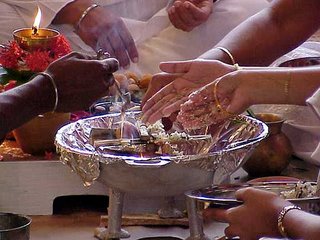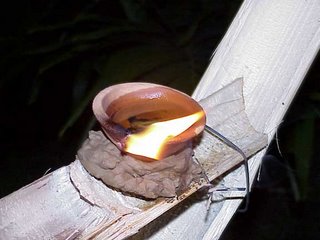[ . BACK to Worldkigo TOP . ]
:::::::::::::::::::::::::::::::::::::::::::::::::::::::::::::::::::::::::::::::::::::::::::::::::::::
Diwali, Divali , Devali
***** Location: India
***** Season: Autumn in India, 15. day of Kartika
..... Near the end of the rainy season in T&T
***** Category: Observance
*****************************
Explanation
 http://hinduism.about.com/library/graphics/lakshmi/wb78.jpg
Divali is an Indian festival and now celebrated in all Indian and Hindu communities worldwide.
http://hinduism.about.com/library/graphics/lakshmi/wb78.jpg
Divali is an Indian festival and now celebrated in all Indian and Hindu communities worldwide.
Diwali (Deepavali, Deepavalli, Deepawali, Devali, Devalli, Dewali, Dewalli) is a five day Hindu festival which occurs on the fifteenth day of Kartika (for example November 12, 2004).
Diwali means "rows of lighted lamps" and the celebration is often referred to as the Festival of Lights. During this time, homes are thoroughly cleaned and windows are opened to welcome
Laksmi, goddess of wealth. Candles and lamps are lit as a greeting to Laksmi. Gifts are exchanged and festive meals are prepared during Diwali. The celebration means as much to Hindus as Christmas does to Christians.
Because there are many regions in India, there are many manifestations of the Diwali festival. In at least one area, the festival begins with Dhanteras, a day set aside to worship Laksmi. In the Indian culture, wealth is not viewed as a corruptive power. Instead, a wealthy person is considered to have been rewarded for good deeds of a past life.
On the second day Kali, the goddess of Strength, is worshipped. This day also focuses on abolishing laziness and evil.
On the third day (the last day of the year in the lunar calendar), lamps are lighted and shine brightly in every home. The lamp symbolizes knowledge and encourages reflection upon the purpose of each day in the festival. The goal is to remember the purpose throughout the year.
The fourth day of Diwali falls on the first day of the lunar New Year. At this time, old business accounts are settled and new books are opened. The books are worshipped in a special ceremony and participants are encouraged to remove anger, hate, and jealousy from their lives.
On the final day (Balipratipada) of the festival, Bali, an ancient Indian king, is recalled. Bali destroyed the centuries old philosophies of the society. However, in addition to this, he is remembered for being a generous person. Thus, the focus of this day is to see the good in others, including enemies.
http://www3.kumc.edu/diversity/ethnic_relig/diwali.html
Lakshmi, here are some LINKS with her pictures:
http://hinduism.about.com/library/weekly/extra/bl-lakshmigallery2.htm
http://hinduism.about.com/library/weekly/extra/bl-lakshmigallery.htm
Here are some LINKS about the fireworks and how children celebrate Devali.
http://www.indianchild.com/diwali.htm
http://www.indianchild.com/festivals_in_india.htm
:::::::::::::::::::::::::::::::::::::::::::::::::::::::::::::::::::::::::::::::::::::::::::::::::::::
 Significance of Lakshmi, Ganesha and Saraswati
Significance of Lakshmi, Ganesha and Saraswati
In Hindu households the worship of Indian deities; Lakshmi, Ganesha and Saraswati is an integral part of the festival of lights ---Diwali.
Lakshmi signifies fortune and prosperity,
Saraswati holding vina represents knowledge and learning and
Ganesha symbolizes the vanquisher of all the obstacles. It is believed worshipping them during Diwali ushers in happiness, wealth, wisdom and prosperity in the family.
© www.craftsinindia.com
:::::::::::::::::::::::::::::::::::::::::::::::::::::::::::::::::::::::::::::::::::::::::::::::::::::
The Ramayana
is the epic story of Lord Rama's life. His story is acted out all over India at this time. In the evening of Divali devotees put out numerous oil lamps so that Lord Rama will find his way home.
You can view a short pictorial story of some of the highlights of Lord Rama's life.

http://www.mahakali.com/divali/rama1.htm
Read about
Deepavali
By Aju Mukhopadhyay, INDIA SAIJIKI, 2006
quote
The Ramayana is one of the two great epics of India and Nepal.
 Rama with Sita
Sita
Rama with Sita
Sita is one of the protagonists and the beloved wife of Rama and the daughter of king Janaka. Rama went to Janakpurdham, current city of Janakpur, Nepal, and got a chance to marry her by lifting a heavy Bow in a competition organized by King Janaka. The competition was to find the most suitable husband for Sita and many princes from different states competed to win her. Sita is the avatar of Goddess Lakshmi, the consort of Vishnu.
Sita is portrayed as the epitome of female purity and virtue. She follows her husband into exile and is abducted by Ravana. She is imprisoned on the island of Lanka until Rama rescues her by defeating the demon king Ravana. Later, she gives birth to Lava and Kusha, the heirs of Rama.
© More in the WIKIPEDIA !
days of harvest
night rest of puppet show
loyalty of Sita to Rama
- Shared by Mokhtar Sah Malik, Malaysia -
Joys of Japan, 2012
*****************************
Worldwide use
KENYA
Diwali (the Kenya spelling) is celebrated in Kenya, mostly by the Indian population. In Kenya, it is generally associated by all and sundry with fire crackers, which are popped all around the country for a few days, as soon as darkness falls.If one mixes a bit more in Indian circles, one might be lucky enough to be given the special sweets (only available for Diwali) and to see the rangoli (coloured patterns made with finely ground chalk) in the temples. There are special concerts (Bollywood music and more!) and no doubt plenty of other activities, including much socialising.
Isabelle Prondzynski
:::::::::::::::::::::::::::::::::::::::::::::::::::::::::::::::::::::::::::::::::::::::::::::::::::::
TRINIDAD AND TOBAGO
Divali, the Festival of lights; also spelt Deepavalee and Diwali - is celebrated around September or October. (It is not a fixed date but a lunar influenced date.) - by Hindus in Trinidad and Tobago. It is a Public Holiday. Hindus use this festival as a thanksgiving to Mother Lakshmi .Divali (the commonly used spelling) celebrates the legendary triumphant return of
Lord Rama and Sita to their Village after many years, and many hardships, and trials in the forest; caused by an evil King. On their return to the village the villagers lit up the houses and pathways; as a symbol of victory of goodness over evil.
 http://www.visittnt.com/ToDo/Events/Divali/images/Puja/Prayhands-Big.jpg
http://www.visittnt.com/ToDo/Events/Divali/images/Puja/Prayhands-Big.jpg
Today the festival's visible highlight is the lighting of deyas at night; Deyas are lit in numbers as many as thousands. Bamboo is an essential element in this festival, as the bamboo is split and bent to hold the deyas. Huge bamboo structures are built in interesting shapes to hold deyas, in homes as well as public spaces. Ghee (clarified butter) is placed in these little clay bowls and a cotton wick to turn them into lamps. When lit, in their vast numbers they are truly a spectacular display.
Although a Hindu Religious festival, it is shared as a community event and is very common to see people from all religous ethics coming out on the streets to light deyas as well as to view the Bamboo sulptures.
DIVALI LIGHTS
(IN MY PHOTO ALBUM --MORE HOLIDAYS)
http://mongst.8k.com/photo.html
Gillena Cox
*****************************
Things found on the way
*****************************
HAIKU
deyas light the night
symbol of victory
good over evil
a twinkle of stars
in the dark night sky; beneath
deyas alight
tonight one tiny light
will spread through out the night in
millions of deyas
gillena 2001
in October
deyas and strings of holly
store decorations
gillena cox 2003
:::::::::::::::::::::::::::::::::::::::::::::::::::::::::::::::::::::::::::::::::::::::::::::::::::::
divaali fire over ~
butterfly sips moisture
from the earth
© Narayanan
xxxxxxxxxxxxxxxxxxxxxxxxxxxxx
Indian Children made Diwali Haiku
We made our own diva lamps and wrote haiku to celebrate Diwali. A diva lamp has a single wick and is usually brightly coloured.
(Unfortunately they do now show the haiku made on that day.)
http://atschool.eduweb.co.uk/manorlh/hinduism/diwali.html
:::::::::::::::::::::::::::::::::::::::::::::::::::::::::::::::::::::::::::::::::::::::::::::::::::::
 ............................ Diwali 2006,
in memory of our dear member at WHCindia
Yajushi (Marella Ram Vinodh)
dark Diwali sky
............................ Diwali 2006,
in memory of our dear member at WHCindia
Yajushi (Marella Ram Vinodh)
dark Diwali sky
has come down on earth-
one starry night
early winter night-
a patch of dark lurking
under each lamp
dark night-
tiny lamps take over
from autumn sun
Diwali night:
sparklers dazzling the dark
as they die
vishnu p kapoor
xxxxxxxxxxxxxxxxxxxxxxxxxxxxx
Fire and Lamps, starry sparks
illumine the hearts in Diwali
temporarily.
Aju Mukhopadhyay
xxxxxxxxxxxxxxxxxxxxxxxxxxxxx
deepavalli -
her face glows as she
lights the lamp
shivkasi -
little diyas send smoke tales
to the Gods
Shivkasi in interior Tamil-Nadu is famous worldwide as a producer of quality fire crackers and infamous because it uses child-labour.
Kala Ramesh
:::::::::::::::::::::::::::::::::::::::::::::::::::::::::::::::::::::::::::::::::::::::::::::::::::::
diyas
in the garden circle
first light
on the 15th October we held a National celebration, in the City's Promenade Gardens, on the first night of Diwali for the Festval of lights
motorcade
under the evening sky
diyas cluster
Laxmi Ma
regal on her lotus
atop the van
There is usually a big motorcade procession of local Mandir on the second night of Diwali.
danielsgy, 2009
Kigo Hotline
:::::::::::::::::::::::::::::::::::::::::::::::::::::::::::::::::::::::::::::::::::::::::::::::::::::
Diwali-
new dress,lot of crackers - and
my parents' blessings
diwali started -
my wife prepares
for making sweets
sound of crackers -
birds flutter and
move from tree to tree
sky draped with
colourful sparks -
stars envy
Ganga Snaan -
remebering my
grandma's oil massage
(
Ganga Snaan - taking bath on diwali day which inolves application of sesame oil all over the body and bathing with steaming hot water. It is believed that this bath on Diwali day is equal to taking a holy dip in the Ganges).
S.B.Vadivelrajan
WHCindia, 2009
:::::::::::::::::::::::::::::::::::::::::::::::::::::::::::::::::::::::::::::::::::::::::::::::::::::
Deepavali is a festival of light; it has different connotations to different sections of the people. While for the children it is an occasion of joy and enjoyment, new clothes, fireworks and good food, the traders celebrate it as the beginning of a New Year. In most of the household men express their reverence to the departed parents and forefathers on this auspicious day. Ladies dress up in their best, and make the celebration grand by their innovative ideas and domestic backup.
In some regions like Bengal and Orissa people worship Mother Kaali, a form of Durga, who destroys all the evils and ushers good. In most part of the country, people worship, Lakshmi, the goddess of wealth. In Indian context, light stands for wisdom and enlightenment. Therefore, the peace-mantra from Rigveda is very relevant and apt for this occasion:
Asotoma sadgamay
tomosoma jyotirgamay
mrutyorma amrutoyagamay
(Lead us from unreal to real, from darkness to light and death to immortality.)
On this great occasion let us greet each other, wish each other for brighter and happier days, peace, joys and prosperity across the world.
festival of light --
kids light up the homes
built in each heart
- Shared by Kumarendra Mallick -
Haiku Culture Magazine, 2013
*****************************
Related words
***** Deya ディヤー diya
a clay jar (about17 cm in diameter) used as an oil lamp during the festival of Devali.
 http://www.visittnt.com/ToDo/Events/Divali/images/Deyas/Deya-Big.jpg
***** House Cleaning for Diwali (saaf safaayi) India
http://www.visittnt.com/ToDo/Events/Divali/images/Deyas/Deya-Big.jpg
***** House Cleaning for Diwali (saaf safaayi) India
The whole house is cleaned and scrubbed. . . till it SHINES!
The servant maid has to help with the cleaning - part of the unworded contract when one employs her!!!
Kala Ramesh
:::::::::::::::::::::::::::::::::::::::::::::::::::::::::::::::::::::::::::::::::::::::::::::::::::::::

A Sanskrit mantra aptly describes the importance of light as emanated by diya on Diwali:
Asato maa sad-gamaya (Lead us from Untruth to Truth)
Tamaso maa jyotir-gamaya (From Darkness to Light)
Mrityor-maa-mritan gamaya (From Death to Immortality)
OM shaanti shaanti shaanti (OM peace, peace peace)
on diwali night...
the diyas eclipses the new moon
at their brim
- Shared by Neelam Dadhwal -
Haiku Culture Magazine, 2013
:::::::::::::::::::::::::::::::::::::::::::::::::::::::::::::::::::::::::::::::::::::::::::::::::::::::
ディープ・ディパワリー祭 / ディパーリー祭
ヒンズー教の灯明の祭り
Enjoy the atmosphere of India, birthland of Daruma san.
. Daruma Forum
[ . BACK to WORLDKIGO . TOP . ]
[ . BACK to DARUMA MUSEUM TOP . ]
:::::::::::::::::::::::::::::::::::::::::::::::::::::::::::::::::::::::::::::::::::::::::::::::::::::
























